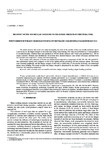| dc.description.abstract | The article discusses the results of a study investigating the effect of the number of fine non-metallic inclusions (up to2μm in size) on the fatigue strength of structural steel during rotary bending. The study was performed on 21 heats producedin an industrial plant. Fourteen heats were produced in 140 ton electric furnaces, and 7 heats were performed in a 100 tonoxygen converter. All heats were desulfurized. Seven heats from electrical furnaces were refined with argon, and heats fromthe converter were subjected to vacuum circulation degassing.Steel sections with a diameter of 18 mm were hardened and tempered at a temperature of 200, 300, 400, 500 and 600◦C.The experimental variants were compared in view of the applied melting technology and heat treatment options. The resultswere presented graphically, and the fatigue strength of steel with a varied share of non-metallic inclusions was determinedduring rotary bending. The results revealed that fatigue strength is determined by the relative volume of fine non-metallicinclusions and tempering temperature. | en_US |

